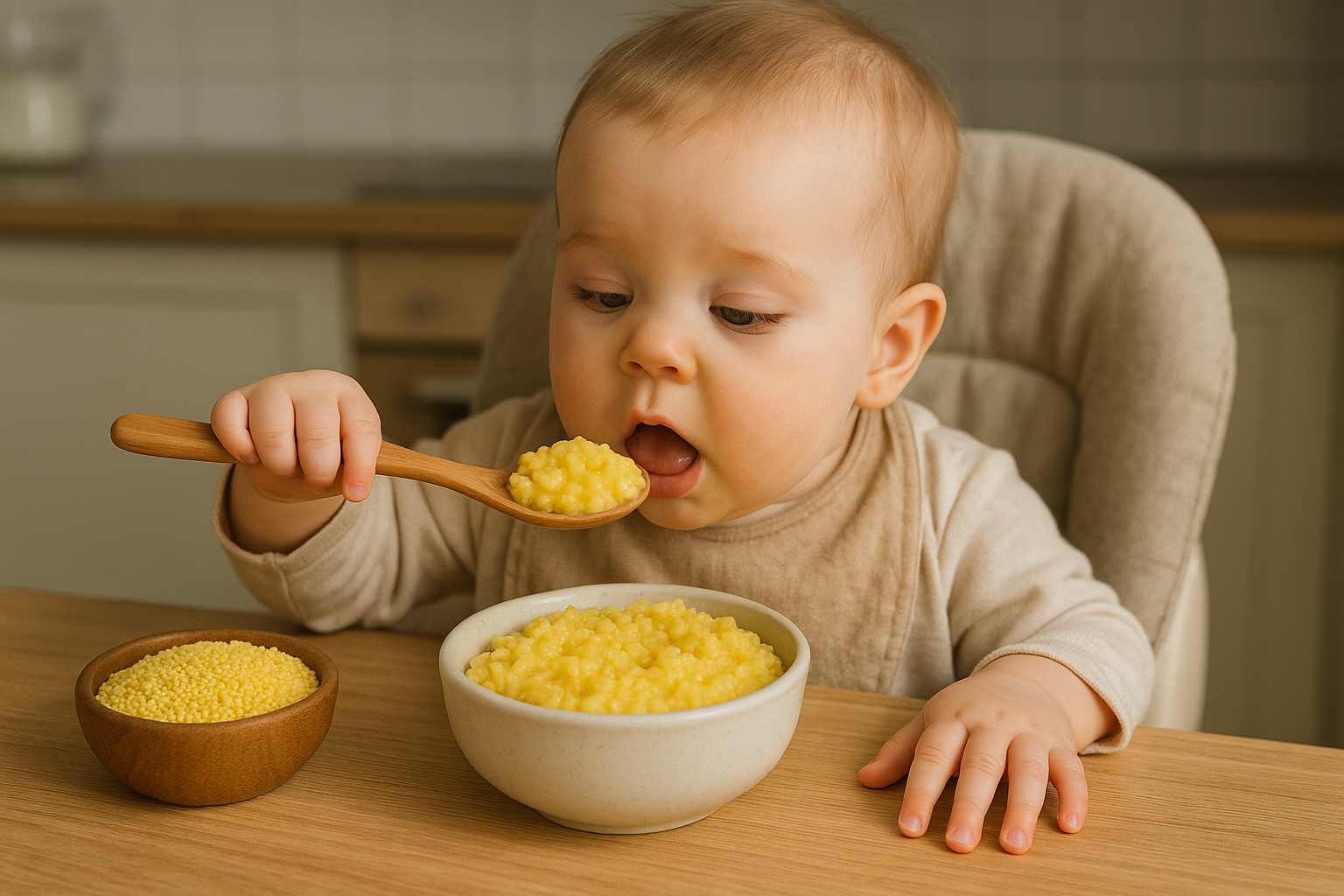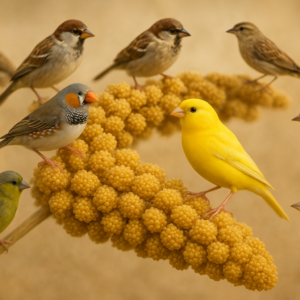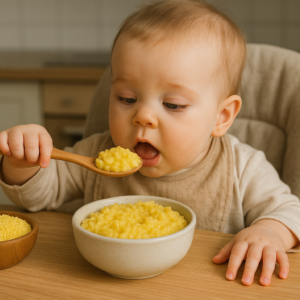Starting your baby on solid foods brings a mix of excitement and questions. You want to choose the right first foods that support healthy growth and development. Many parents today are rediscovering ancient grains like yellow millet, a nutrient-rich option that has fed communities for thousands of years.
Yellow millet, often called foxtail millet, stands out as one of the most digestible grains you can introduce to babies. This small yellow grain packs protein, fiber, vitamins, and minerals into each serving. Let’s explore when and how to safely add millet for babies into your little one’s diet.
Understanding Yellow Millet: What Makes It Special?
Yellow millet refers to foxtail millet, a small-seeded grain with a characteristic yellow hue. Foxtail millet serves as a great source of protein and fiber, making it ideal for babies starting on solids, and contains B vitamins that support a baby’s nervous system and skin health.
The grain grows quickly in challenging conditions where other crops struggle, making it a staple across Asia and Africa for millennia. Its resilience as a crop translates to nutritional resilience for growing babies.
When Can Babies Start Eating Yellow Millet?
Pediatricians recommend introducing millet to babies after they cross six or eight months. The six-month mark typically signals readiness for solid foods, when babies can sit upright and show interest in eating.
Here’s why this timing works:
Starting at 6 Months Your baby’s digestive system develops enough to handle semi-solid foods around this age. The ideal time to introduce millets to babies is around 6 months of age, when they’re transitioning from breast milk or formula to solid foods. Always consult your pediatrician before introducing new foods, especially if your baby has allergies or digestive concerns.
Progressive Introduction Start with a single teaspoon of millet porridge and watch for any reactions over three days. If your baby tolerates it well, gradually increase the quantity. This approach helps you identify potential sensitivities early.
Nutritional Benefits of Millet for Babies
All types of millet offer carbohydrates, fiber, and protein, along with calcium, folate, vitamin B6, and zinc, while also being rich in antioxidants and offering iron. Let’s break down what these nutrients do for your baby:
Protein for Growth
Foxtail millet contains protein levels higher than wheat and plays a vital role in the body of a growing baby. Protein builds cells, tissues, and muscles as your baby grows.
Fiber for Digestion
Millets are rich in fiber and complex carbohydrates, which ease constipation issues common in babies and keep them full for longer. The fiber content supports healthy bowel movements and prevents digestive discomfort.
B Vitamins for Development
The B-vitamin complex in yellow millet supports energy production and brain development. These vitamins help convert food into fuel for your baby’s active exploration and play.
Minerals for Strong Bones
Millets are high sources of minerals and important nutrients, including calcium, copper, manganese, phosphorus, and magnesium. These minerals work together to build strong bones and support overall development.
Easy Digestibility
Millets are gluten-free and easy to digest, more so when they’re sprouted, making them ideal for babies whose digestive systems are still developing. This gentle quality reduces the risk of digestive upset.
Want to know Which Millets Is Good for Babies for better nutrition and growth? — please read this blog!
Comparing Yellow Millet to Other First Foods
When exploring grain options for your baby, understanding how yellow millet stacks up against other choices helps you make informed decisions.
Yellow Millet vs. Rice Foxtail millet is said to be about 30 times higher in fiber when compared to rice. While rice serves as a traditional first food, yellow millet offers superior fiber content and protein levels.
Yellow Millet vs. Wheat Wheat contains gluten, which some babies may struggle to digest. Yellow millet provides a gluten-free alternative with comparable nutritional benefits. For babies with celiac disease or gluten sensitivity, millet offers a safe grain option.
Nutrient Density Each type of millet ranks better than rice and wheat in terms of nutritional profile, making millet one of the most suitable first food choices for babies. This superior nutrition density means your baby gets more nutrients per serving.
How to Prepare Yellow Millet for Babies (6-12 Months)
Proper preparation makes yellow millet safe and enjoyable for babies. Follow these steps for different age groups.
Basic Yellow Millet Porridge (6+ Months)
Ingredients:
- 2 tablespoons yellow millet (foxtail millet)
- 1 cup water
- Breast milk or formula for consistency
Preparation:
- Rinse the millet thoroughly under cold water
- Soak for 2-3 hours or overnight to improve digestibility
- Drain and add to a pot with fresh water
- Bring to a boil, then reduce heat to low
- Cover and simmer for 20 minutes until soft
- Mash or blend to achieve smooth consistency
- Mix in breast milk or formula to reach desired thickness
- Let cool to safe temperature before serving
Start with thin consistency and gradually thicken as your baby gets comfortable with the texture.
Yellow Millet and Vegetable Khichdi (8+ Months)
Ingredients:
- 2 tablespoons yellow millet
- 1 tablespoon yellow moong dal
- 1/4 cup mixed vegetables (carrot, pumpkin, peas)
- 1.5 cups water
- Pinch of turmeric
- 1/2 teaspoon ghee
Preparation:
- Rinse and soak millet and dal for 30 minutes
- Chop vegetables into small pieces
- Pressure cook all ingredients with water and turmeric for 3 whistles
- Let pressure release naturally
- Mash the mixture with the back of a spoon
- Add ghee before serving
This recipe provides a complete meal with protein, vegetables, and grains.
Yellow Millet Banana Pancakes (9+ Months)
Ingredients:
- 3 tablespoons yellow millet flour
- 1 ripe banana, mashed
- 2 tablespoons water or breast milk
- Pinch of cinnamon (optional)
Preparation:
- Mix all ingredients into a thick batter
- Heat a non-stick pan on low flame
- Pour small portions to make mini pancakes
- Cook until bubbles form on surface
- Flip and cook the other side until golden
- Cut into small pieces for self-feeding
These pancakes work well as finger foods for babies practicing self-feeding.
Safety Considerations and Potential Concerns
While millet for babies offers numerous benefits, parents should keep certain points in mind.
Choking Prevention
Cooked millet presents a low risk when safely prepared for a child’s age and developmental ability, though loose grains are more likely to scatter in the mouth, which can cause gagging or coughing. Mash the grains with a fork or mix them into other foods to help them stick together.
Allergies
Millet is not a common allergen and allergies to millet are rare. Start with small amounts and watch for any adverse reactions like rashes, digestive upset, or breathing difficulties.
Moderation Matters
Excessive millet consumption may interfere with thyroid gland function and affect digestion because of complex carbohydrates and high fiber content, making it essential to feed babies millet and millet-based foods in moderate amounts. Offer millet 2-3 times per week rather than daily.
Balanced Diet Approach
Millets are nutritious but not the only thing your child should grow up on, as a balance of grains, pulses, lentils, vegetables, fruits, nuts, seeds, and probiotics is essential for proper growth and development. Rotate different foods to provide complete nutrition.
Yellow Millet for Weight Gain in Babies
Parents of underweight babies often seek foods that support healthy weight gain. Yellow millet can help.
Studies show that any type of millet-based meals, including finger millet, sorghum, and mixtures of millets like finger, pearl, foxtail, and Kodo millet, help increase the weight and height of babies, children, and teens.
The complex carbohydrates in yellow millet digest slowly, providing sustained energy. The high protein content supports muscle development rather than just fat accumulation. This combination promotes healthy weight gain with proper nutrition.
Sourcing Quality Millet Products
Finding quality millet products matters for your baby’s health and safety.
What to Look For:
- Organic certification when possible
- Clean, unblemished grains
- Proper packaging that prevents contamination
- Clear labeling with processing information
Storage Tips:
- Store uncooked millet in airtight containers
- Keep in a cool, dry place away from direct sunlight
- Use within 6 months for best quality
- Check for any signs of moisture or pests before use
Companies like CMS Industries focus on agricultural product quality, though they primarily deal with grains, pulses, and spices for wholesale and export markets. For baby-specific millet products, look for brands that specialize in infant nutrition.
Discover why yellow millet is the best feed for your pet birds and keeps them healthy and happy — please read this blog!
Expert Tips for Success with Yellow Millet
Making millet work for your baby involves some practical strategies.
Start Simple Begin with plain millet porridge before combining with other ingredients. This approach helps you identify any sensitivities and lets your baby learn the taste.
Texture Progression Move from smooth purees to slightly textured mashes to soft lumps as your baby develops chewing skills. Watch your baby’s cues to guide progression.
Flavor Combinations Once your baby tolerates plain millet, experiment with:
- Sweet options: banana, dates, apple sauce
- Savory options: pumpkin, sweet potato, carrots
- Spices: cinnamon, cardamom (in small amounts)
Temperature Check Always test food temperature before serving. Millet retains heat, so let it cool adequately to prevent burns.
Consistency Matters Mix cooked millet into soft, scoopable food like mashed vegetables, stewed greens, or yogurt to help bind the tiny grains together and minimize mess.
Regional Variations and Cultural Preparations
Different cultures have unique ways of preparing yellow millet for babies. These traditional methods offer time-tested approaches.
South Indian Style Prepare millet porridge with jaggery and cardamom for a sweet breakfast option. The natural sweetness appeals to babies while providing iron from jaggery.
African Preparations Cook millet with groundnuts (peanuts) for older babies who can handle nuts. This combination provides complete protein.
Chinese Methods Prepare thin millet congee, similar to rice porridge, often combined with small amounts of meat or fish broth for added nutrition.
Transitioning from 6 Months to 1 Year
Your baby’s millet consumption changes as they grow through the first year.
6-8 Months:
- Serve smooth, thin porridge
- Offer once daily to start
- Mix with familiar foods
- Keep portions small (2-3 tablespoons)
8-10 Months:
- Introduce thicker consistency
- Combine with vegetables and lentils
- Offer millet-based khichdi
- Increase to 4-5 tablespoons per serving
10-12 Months:
- Add millet pancakes and dosas
- Let baby self-feed soft millet preparations
- Include in family meals (modified texture)
- Serve 1/4 to 1/3 cup per meal
Addressing Common Parent Concerns
Parents often have questions when introducing new foods. Here are answers to common concerns.
“My baby refuses millet. What should I do?”
Babies often need multiple exposures to accept new foods. Mix small amounts into foods your baby already enjoys. Try different preparation methods to find what works.
“Can I use store-bought millet flour?”
Yes, but ensure it comes from a trusted source and is fresh. Freshly ground flour offers better nutrition, but packaged flour works when properly stored.
“Should I use sprouted millet?”
Sprouted millet offers improved nutrient availability and easier digestion. If you can find or prepare sprouted millet, it makes an excellent choice for babies.
“How do I know if my baby is having an allergic reaction?”
Watch for symptoms like skin rashes, swelling, vomiting, diarrhea, or breathing difficulties within hours of eating. Contact your pediatrician immediately if you notice these signs.
The Role of Agricultural Quality
The quality of millet you use starts at the source. Agricultural practices affect the nutritional value and safety of grains.
Organizations like CMS Industries work with farmers across India to ensure quality agricultural products reach markets. While CMS Industries focuses on bulk exports of grains, pulses, and spices, their commitment to quality agricultural practices highlights why sourcing matters.
When buying millet for your baby, consider:
- Where and how the grain was grown
- Whether it underwent proper cleaning and processing
- How long it has been stored
- What handling procedures were followed
These factors influence both safety and nutritional content.
Combining Yellow Millet with Other Nutritious Foods
Yellow millet works well as part of a varied diet. Combine it strategically for complete nutrition.
Protein Pairs:
- Yellow moong dal (split mung beans)
- Chicken or fish (for older babies)
- Yogurt (if dairy is introduced)
- Eggs (scrambled and mixed)
Vegetable Combinations:
- Carrots (vitamin A)
- Spinach (iron and folate)
- Pumpkin (beta-carotene)
- Sweet potato (complex carbs)
Healthy Fats:
- Ghee (clarified butter)
- Coconut oil
- Avocado (for older babies)
- Ground nuts or nut butters (after 1 year)
These combinations provide balanced meals with complete amino acid profiles and diverse micronutrients.
Conclusion
Yellow millet stands out as an excellent first food for babies starting solids at 6 months. Its rich nutritional profile, easy digestibility, and versatility make it ideal for supporting healthy growth and development. Millet is easy to digest, supports bone development, and reduces constipation, addressing common concerns parents face when introducing solid foods.
Start slowly with simple preparations, watch for any reactions, and gradually incorporate millet into your baby’s varied diet. Remember that no single food provides complete nutrition. Use millet as part of a balanced approach that includes various grains, proteins, vegetables, and fruits.
Always consult your pediatrician before introducing new foods, especially if your baby has health concerns or a family history of allergies. With proper preparation and mindful introduction, yellow millet can become a nutritious staple in your baby’s diet from 6 months through their first year and beyond.
Frequently Asked Questions
Q1: Can I give yellow millet to my 6-month-old baby daily?
Start with 2-3 times per week rather than daily. While yellow millet offers excellent nutrition, variety in your baby’s diet provides more complete nutrition. Rotate different grains like rice, oats, and millet throughout the week. This approach prevents potential issues from excessive consumption while exposing your baby to different tastes and textures that support healthy eating habits.
Q2: Is yellow millet better than white rice for babies?
Yellow millet provides more protein and fiber than white rice, making it nutritionally superior. The fiber helps prevent constipation, a common issue in babies starting solids. White rice digests easily but lacks the fiber and protein density of millet. Both grains have their place in a baby’s diet, offering different benefits and textures that support varied nutrition.
Q3: How should I store cooked yellow millet for my baby?
Store cooked millet in an airtight container in the refrigerator for up to 2 days. Cool the millet quickly after cooking by spreading it in a shallow container before refrigerating. When reheating, add breast milk, formula, or water to restore creamy consistency. Freeze portions in ice cube trays for convenient single servings that last up to 1 month. Always smell and examine food before serving.
Q4: Can yellow millet cause constipation in babies?
Yellow millet actually helps prevent constipation because of its high fiber content. The fiber promotes healthy bowel movements and supports digestive health. Start with small amounts and increase gradually to allow your baby’s digestive system to adjust. Ensure your baby drinks adequate water or breast milk alongside solid foods. If constipation occurs, reduce the amount temporarily and consult your pediatrician.
Q5: What’s the difference between yellow millet and other colored millets?
Yellow millet typically refers to foxtail millet, which has a naturally yellowish appearance. Different millet varieties offer slightly different nutritional profiles. Finger millet (ragi) appears darker and contains more calcium. Pearl millet (bajra) is larger and provides more energy. All millets share common benefits like being gluten-free and highly digestible, making any variety suitable for babies when properly prepared.





